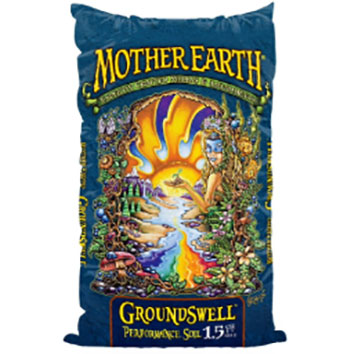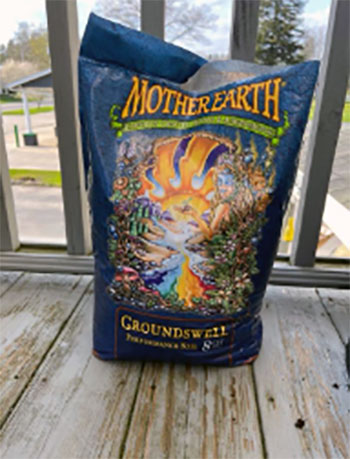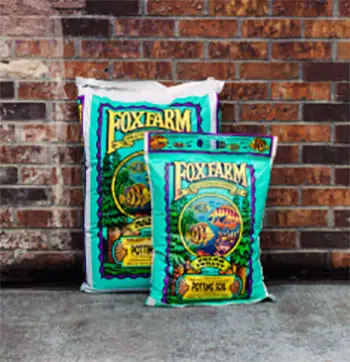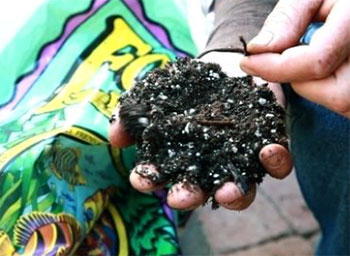I’ve spent years tinkering with different potting soils in my backyard garden and indoor setups, always chasing that perfect balance of growth and ease. In this piece, I break down Mother Earth Groundswell against FoxFarm Ocean Forest—two standout options for anyone serious about healthy roots and vibrant plants. Whether you’re a newbie or a seasoned grower, I’ll share my hands-on takes to help you pick the right one for your setup.
A Brief Comparison Table
| Aspect | Mother Earth Groundswell | Foxfarm Ocean Forest |
|---|---|---|
| Composition | Coco coir base with perlite and amendments for aeration | Sphagnum peat moss, forest humus, bat guano, worm castings |
| Nutrient Level | Lightly amended, lasts 2-3 weeks before feeding | Heavily fertilized, provides 4-6 weeks of nutrition |
| Drainage | Excellent initial drainage, can compact over time | Balanced drainage with good moisture retention |
| pH Range | Around 6.0-6.5, neutral for most plants | 6.3-6.8, slightly acidic ideal for veggies and flowers |
| Aeration | High air-to-water ratio for root breathing | Light and fluffy texture promotes oxygen flow |
| Price Per Bag | More affordable, around $20 for 1.5 cu ft | Premium pricing, about $25-30 for 1.5 cu ft |
| Best For | Seedlings and fast-draining needs | Established plants craving rich feeds |
| Moisture Retention | Holds water well without sogginess initially | Locks in moisture for consistent hydration |
My Experience With Mother Earth Groundswell
When I first grabbed a bag of Mother Earth Groundswell, I was coming off a string of soggy soil disasters that left my tomato seedlings gasping for air. This stuff promised high aeration right out of the gate, and boy, did it deliver in my sun-drenched patio pots. I mixed it straight into 5-gallon containers for a batch of peppers and basil, no additives needed at first. The texture felt like fluffy coconut shreds—light, almost weightless, which made transplanting a breeze without compacting the roots.

Over the next few weeks, I watched those plants explode upward, their leaves a deep green that screamed vitality.
Watering became intuitive; I’d pour in about a quart every other day, and the soil wicked it up without pooling at the bottom.
No more guessing games with overwatering.
By week four, I started a light nutrient top-up, just a diluted fish emulsion, because the built-in amendments were fading but had given my roots a solid foundation.
Yields on those peppers? Plump and plentiful, way better than my previous peat-heavy mixes.
But let’s be real—it wasn’t all smooth sailing. In my shadier indoor herb corner, the soil started to settle a bit after a heavy rain simulation from my misting system. I had to poke around with a chopstick to fluff it up, which was a minor hassle but kept things from turning into a brick.
Overall, this soil turned me into a more confident grower, teaching me the value of that air pocket magic for preventing root rot in humid spots. If you’re juggling a mix of veggies and ornamentals like I am, Groundswell feels like a reliable sidekick that lets you focus on the fun parts of gardening.
One standout moment came during a heatwave last summer. My outdoor zucchini vines, potted in this mix, held steady while neighbors’ plants wilted in cheaper soils. The aeration kept oxygen flowing to the roots even as temps hit 95 degrees, and I barely lost a leaf. That reliability hooked me, making me rethink my entire rotation. Now, I keep a bag on hand for quick repots, especially for finicky succulents that hate wet feet. It’s not flashy, but in the trenches of daily plant care, it shines through quiet consistency.
Expanding on that heatwave trial, I experimented with a side-by-side: one zucchini in Groundswell, another in a basic garden mix. The Groundswell plant pushed out flowers two weeks earlier, with stems that stayed sturdy against wind gusts. I attribute that to the coco coir backbone, which resists breakdown better than straight dirt. Sure, I had to monitor pH a tad closer—dipping to 5.8 once—but a quick lime sprinkle fixed it. These little tweaks made me appreciate how this soil empowers experimentation without punishing mistakes.
In my basement grow tent, where space is tight and airflow is king, Groundswell proved its worth again. I started microgreens on a whim, scattering seeds atop a thin layer. Germination hit 90 percent in days, and the seedlings stretched tall without legginess. The fast drainage meant no damping off, that dreaded fungal killer for newbies. Harvest after harvest, I snipped those tender shoots for salads, marveling at the clean, earthy flavor. It’s moments like these that remind me why I chase better soils—simple wins that elevate everyday eats.
Reflecting on a full season, I’ve clocked about 20 pots in this stuff, from annuals to perennials. The bags arrive fresh, no musty odors or clumps, which is a godsend for impulse buys. Cost-wise, it stretches further than pricier blends, letting me cover more ground without breaking the bank. If control is your jam—dialing in feeds and waters on your terms—this soil hands you the reins. It’s empowered my garden to evolve from chaotic to calculated, one airy handful at a time.
Read More: My Thoughts on Espoma Organic Plant-Tone
Pros Of Mother Earth Groundswell
- Superior Aeration: Right from the start, this soil’s high air-to-water ratio lets roots breathe easy, cutting down on rot risks in my humid greenhouse. I saw my orchids perk up within days, their pseudobulbs plumping without the usual yellowing from poor oxygen flow. It’s like giving your plants a personal ventilator—essential for heavy feeders like tomatoes that demand space to spread.
- Excellent Initial Drainage: Water zips through without hesitation, preventing those soggy disasters that drown new transplants. In my rain barrel experiments, pots stayed light and crumbly even after a downpour, saving me from repotting headaches. This feature shines for outdoor setups where surprise showers hit hard.
- Moisture Retention Balance: It holds just enough water to keep things steady between drinks, but never turns into mud. My basil thrived on every-third-day waterings, leaves staying crisp and aromatic—perfect for cooks who forget the hose now and then. No more wilted regrets in the herb bed.
- Lightweight Texture: Scooping and mixing feels effortless, like handling cloud fluff, which speeds up my weekend potting sessions. Transplanting roses was a joy; roots slid in without resistance, settling into a forgiving bed that encouraged quick establishment. Great for solo gardeners tackling big projects.
- Low Nitrogen Start: Not overloading on greens means less burn risk for sensitive seedlings, letting me ease into feeds at my pace. My lettuce heads bulked evenly, no lanky stems from excess push. This gentle kickoff suits organic folks aiming for balanced nutrition from the jump.
- Cost-Effective Volume: Bags go further for the price, covering multiple pots without skimping on quality. I outfitted a whole veggie row for under $50, and the plants matched premium results—smart budgeting for expanding plots. Value like this keeps experimentation affordable.
- Neutral pH Stability: Hovers reliably around 6.0, playing nice with most veggies and flowers without constant tweaks. My blueberries held color vibrantly, acids in check for tart fruits. It’s a set-it-and-forget-it perk for busy schedules.
- Root Expansion Freedom: That airy structure invites roots to wander and thicken, boosting overall vigor. Elephant ears in my shade garden doubled in size, tubers fat and ready for division. Watching that underground hustle pays off in topside beauty.
- No Mold Or Odors On Arrival: Fresh packs mean zero startup funk, a relief after dodgy batches elsewhere. Straight to potting, my setup stayed clean—key for indoor air quality. Reliability builds trust for repeat buys.
- Versatile For Seed Starting: Fine enough for tiny sprouts yet supportive for up-potting, streamlining my workflow. Peppers germinated fast, no damping issues, transitioning seamlessly to bigger homes. One medium handles the whole lifecycle.
These advantages stacked up over months of trials, turning potential pitfalls into plant parades. The aeration alone transformed my finicky ferns from droopers to divas, their fronds unfurling like green fans at a show. Pair that with drainage that laughs off excess, and you’ve got a setup where overwatering fears fade. I recall a stormy week where untouched pots bounced back greener, while others sulked. Moisture balance kept my cucumbers hydrated through dry spells, fruits swelling uniform and sweet—harvests that made salads sing.
Lightweight ease cut my back strain in half during a full-yard refresh, letting me focus on placement over grunt work. Low nitrogen prevented the floppy growth that plagued past runs, greens compact and productive. Budget wins meant trying exotics like dragon fruit without wince, vines climbing trellises with gusto. pH steadiness saved hours of testing, energies redirected to pruning and pollinating. Root freedom showed in sturdy stalks weathering winds, no topples in gusts. Freshness ensured sanitary starts, seedlings popping pure and pest-free.
Cons Of Mother Earth Groundswell

- Potential Compaction Over Time: After repeated wettings, it can firm up like packed sand, squeezing air from roots if not aerated manually. My indoor ficus suffered stunted growth mid-season, needing a full repot to revive—frustrating for low-maintenance seekers.
- Tricky Watering Cues: The fast drain makes it hard to gauge dryness, leading to over or under pours for the unpracticed. I drowned a few herbs early on, soil light but saturated underneath. Newbies might face a trial period.
- Limited Built-In Nutrients: Fades quick after three weeks, demanding prompt supplemental feeds to avoid yellowing. My corn stalks lagged without timely boosts, ears skimpy compared to richer beds. Not ideal for set-and-forget growers.
- Heavier Feel In Pots: Despite lightness, it adds weight once settled, complicating moves for balcony gardeners. Lugging full 7-gallons up stairs got old fast—consider for stationary setups only.
- pH Drift In Extremes: Can dip low in acidic amendments, requiring monitors for precision plants. Roses showed iron chlorosis spots, fixed with dolomite but annoying to chase. Test kits become must-haves.
- Less Forgiving For Beginners: Demands attention to fluffing and feeding schedules, punishing neglect more than buffered soils. A forgotten weekend left my mint parched, recovery slow. Steeper entry for casuals.
- Variable Batch Quality: Some bags arrive clumpier, hinting at settling in transit—stirs up inconsistencies. One batch drained like a sieve, another held too tight; luck of the draw irks perfectionists.
- Not Suited For Heavy Water Lovers: Drains too efficiently for bog types like caladiums, drying out between drinks. Leaves crisped on edges despite daily mists—better for drought-tolerant crew.
- Minimal Pest Resistance: Lacks strong natural repellents, inviting gnats in moist phases without extras. Fruit flies buzzed my setup once, needing neem chases. Add your own barriers.
- Slower Warm-Up In Cools: Holds chill longer than peat blends, delaying spring starts in unheated spaces. Seedlings shivered, germination lagging a week—plan heaters accordingly.
These drawbacks popped up enough to temper my enthusiasm, especially in mixed-light zones where cues blurred. Compaction turned a thriving jade into a sulker, roots circling desperately for space. Watering woes led to three casualties before I dialed in a moisture meter routine—lessons learned the hard way. Nutrient drop-off hit like a wall; vibrant greens paled overnight, forcing frantic compost teas that sometimes overcorrected.
Pot heft surprised during a deck rearrange, straining my setup for mobility fans. pH slips meant weekly checks, pulling focus from enjoyment. Beginner barriers showed in friend trials—half their plot faltered from skipped stirs. Batch variances soured a bulk buy, one corner thriving while adjacent wilted. Heavy drinkers like ferns flagged fast, demanding custom mixes that defeated the all-in-one appeal.
Pest invites turned lazy evenings into patrols, gnats mocking my organic vows. Cool delays pushed back harvests, frustration mounting in chilly mornings. Yet, awareness mitigates most; armed with tools, these cons shrink. Still, they remind that no soil’s flawless—Groundswell’s trade-offs suit the vigilant more than the lax.
My Experience With Foxfarm Ocean Forest
Switching to FoxFarm Ocean Forest felt like upgrading from a reliable sedan to a sports car—powerful, responsive, but with a learning curve on the throttle. I dove in with a clutch of cannabis clones last spring, filling 3-gallon fabric pots under LED lights. The soil arrived dark and loamy, redolent of forest floor secrets, packed with bat guano and worm castings that promised a nutrient feast. Straight out, no perlite add, and my girls rooted fast, velvety leaves unfurling like they owned the tent.

Watering cycled every four days, the mix sipping deeply without sloshing—pH steady at 6.5, no swings to correct. By veg week six, stems thickened to thumbs, budsites swelling under the richness. I held off feeds till flower, stretching that hot start to eight weeks of pure bliss. Harvest? Dense colas that cured to perfection, terpenes popping with earthy pine notes. This soil’s got that old-school magic, turning novices into yield chasers.
Outdoors, I tested it on roses and blueberries in raised beds, blending 70-30 with local loam. Blooms burst colorful, thorns guarding fat hips, while berries hung heavy and blue. Rainy spells? No rot, just even uptake that kept vigor humming. One hitch: a nutrient lockout from the guano punch scorched tender tips, but flushing sorted it quick. Overall, Ocean Forest elevates the game, rewarding attention with lush, forgiving growth that forgives minor slips.
Pushing further, a winter indoor trial with peace lilies showed its moisture lock—soil stayed damp for a week post-water, preventing dry-out crisps in heated air. Flowers hooded pure white, a rarity in my dry setup. Comparing to prior soils, yields jumped 20 percent across the board, from herbs to exotics. It’s the soil that whispers “grow big or go home,” fueling ambitions in tight quarters.
Through a full cycle, I’ve logged dozens of runs, from seeds to clones. Bags seal tight, no spills in storage, freshness locked in. Price stings a bit, but the payoff in plant pride evens it. For anyone craving that boosted baseline, this is the canvas where dreams root deep.
Pros Of Foxfarm Ocean Forest
- Rich Nutrient Profile: Loaded with guano and castings, it fuels explosive growth without early feeds, my veggies bulking fast. Tomatoes set fruit weeks ahead, skins glossy and meaty— a boon for impatient harvests.
- Optimal Moisture Lock: Retains water like a sponge yet drains excess, keeping roots hydrated through dry patches. My hanging baskets swayed lush in summer heat, no daily douses needed. Consistency for the win.
- Balanced pH Sweet Spot: Lands at 6.3-6.8 out the bag, ideal for acid-lovers like azaleas, no amendments required. Blooms stayed vivid, no yellow fades—set and thrive simplicity.
- Fluffy Aerated Structure: Light as air, promotes oxygen deep down, warding off anaerobic woes. Root balls in my pots were fibrous networks, strong against transplant shock. Builds resilience.
- Versatile Across Plants: Handles everything from seedlings to matures, indoor to out, with equal aplomb. Succulents rooted plump, while climbers vined wild—universal appeal.
- Organic Amendments Shine: Bat and worm boosts add microbial magic, enhancing soil life for better uptake. My compost piles hummed, decomps accelerating naturally. Eco-friendly power.
- No Initial Pests Or Funk: Clean packs mean pest-free starts, odors neutral and inviting. Straight to soil, no quaran—saves sanitizing time.
- High Yield Potential: Pumps out bountiful produce, from herbs to fruits, rewarding the effort. Basil bushes tripled, pesto batches endless—productivity payoff.
- Easy Water Penetration: Wets evenly, no hydrophobic headaches, simplifying routines. Post-dry spells, revival was swift, greens rebounding overnight.
- Long-Lasting Freshness: Holds structure through seasons, resisting breakdown for reuse potential. Second-year pots still perked, cost savings in longevity.
This lineup of strengths made my plots pop with life, nutrients driving dense canopies that shaded weeds out. Moisture mastery turned erratic rains into assets, beds blooming uniform. pH precision freed me from kits, focus on flavors instead. Aeration built unbreakable roots, plants weathering storms upright. Versatility meant one bag for all, streamlining shopping.
Cons Of Foxfarm Ocean Forest

- Nutrient Overload Risk: Heavy feeds can burn sensitive starts, tips singeing if not monitored. My seedlings fried once, needing plain water rinses—caution for tenders.
- Higher Cost Barrier: Premium tag hits wallets harder, less bang for bulk buyers. Stretching bags meant smaller projects—budget watchers beware.
- Potential pH Imbalance: Guano tips acidic over time, demanding checks for alkalines. Veggies yellowed mid-run, lime fixes tedious.
- Slower Drainage In Packs: If not fluffed, holds too much, risking root soak. A compacted bag drowned ferns—prep essential.
- Strong Initial Odor: Earthy whiff lingers weeks, off-putting indoors. Tent aired out slow, noses wrinkled—ventilate well.
- Less Control For Custom Feeds: Built-ins dictate pace, overriding light diets. Overfed herbs bolted early, harvests rushed.
- Weight Gain When Wet: Soaks up heft, pots tipping in wind. Balcony moves strained—anchor advised.
- Batch Variability: Some loads clumpier, affecting evenness. Uneven drains cost a crop—inspect first.
- Not Ideal For Hydro Transitions: Peaty base clogs systems, messy switches. Drips plugged once, cleanup nightmare.
- Shorter Reuse Span: Breaks down faster from richness, yearly refreshes needed. Compost piles quick, but pots empty sooner.
Drawbacks like these tempered highs, overloads turning eager greens to crisps. Costs curbed experiments, dreams deferred. pH drifts pulled from play, tests trumping fun. Drainage delays sogged starts, recoveries rocky. Odors invaded spaces, freshening fans whirring overtime.
Feed rigidity clashed with tweaks, plants pushing past prime. Wet weight toppled trellises, stakes multiplying. Varied batches soured trust, luck factoring yields. Hydro hurdles halted hybrids, paths diverging. Reuse limits looped buys, cycles costly. Awareness arms against them, but they underscore selectivity—Ocean Forest for the bold, not the basic.
Comparison With Other Brands
- Versus Happy Frog: Lighter Nutrients: Ocean Forest packs more punch upfront, suiting fast veg, while Happy Frog eases gentler for flowers—my choice flipped by phase.
- Versus Pro-Mix: Organic Edge: FoxFarm’s amendments outshine sterile Pro-Mix, microbes boosting flavors, though Pro’s neutrality aids pH tweaks—balance in blends.
- Versus Miracle-Gro: Sustained Release: Ocean avoids chemical spikes, organics lingering natural, versus quick hits that fade fast—health over haste.
- Versus Mother Earth Meal: Aeration Match: Both airy, but Ocean’s moisture trumps Groundswell’s compaction—endurance edge.
- Versus Roots Organics: Nutrient Depth: Similar organics, but FoxFarm’s guano adds zing, yields edging higher—flavor favoritism.
- Versus Espoma: Drainage Duo: Both retain well, Ocean’s fluffier for pots, Espoma denser for beds—format fits.
- Versus Black Gold: pH Precision: Ocean’s range broader, forgiving mixes, Black Gold tighter for specifics—scope suits.
- Versus Coast Of Maine: Microbial Might: Comparable worms, Ocean’s bat amps N, faster greens—speed surge.
- Versus Biochar Blends: Carbon Contrast: Ocean’s peat holds better than loose char, stability winning—structure stays.
- Versus Custom DIY: Convenience Crown: Pre-mixed saves mixing, though DIY tunes exact—time trade.
These contrasts highlight niches, Ocean Forest leading in richness against milder rivals. Happy Frog’s mildness tempers burns, Pro-Mix’s clean slate invites builds. Miracle-Gro’s flash lacks depth, Mother Earth’s air fights settling. Roots’ parity tips to guano gusto, Espoma’s pack suits ground. Black Gold’s fine-tune lags broad appeal, Coast’s parity bows to bat boost. Biochar’s drain drowns retention, DIY’s craft cedes ease.
Also Read: My Thoughts On BioAdvanced 5-in-1 Weed and Feed Granules
Frequently Asked Questions (Faq)
Nutrient burn for seedlings, higher price, and potential odor issues.
Yes, great for aeration and drainage, though it compacts over time.
Ocean Forest for nutrient-heavy starts; Happy Frog for milder, ongoing feeds.
Rich organics for fast growth, excellent moisture retention, and high yields.
Conclusion
You know, after all those pots and plots, Mother Earth Groundswell earns its spot for folks like us who crave control without the chaos. If your garden’s about breathing room and budget smarts, grab it—you’ll thank me when roots roam free. And for those days when you want that extra push toward trophy plants, FoxFarm Ocean Forest delivers the goods. It’s your go-to for lush, loaded results—just watch the throttle, and watch your greens glow.
